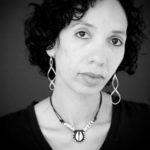This piece explores using family photos and other personal items as a way to enter poems. Writers can use journals, family photos, oral histories and/or a combination of the above as writing prompts to enter poems. Questions that often come up when using photos or oral histories to enter our poem, include: Whose story are we telling? How important is it that our poems be historically accurate? When do we give ourselves permission to honestly write our painful stories? What family secrets are waiting to be written? Is this our story to tell? You can use family photos, personal journals, and objects of personal significance as writing prompts.
I used family photographs, journals and oral family history in my debut poetry collection SAY/MIRROR (The Operating System). To understand why we write our Herstories into poems, I often ask what value does this serve? Below are some of the answers that explain the importance of using parts of our past, via personal objects or oral Herstories, when combining memoir and poetry.
Why is it important to write ourselves into our poems and to use these objects from our past or our family’s past?
1) To say we were here, this was our past, this was our family, these are our stories.
2) To show what we have survived and to make peace with our past.
3) It is important to celebrate our past and often, celebrate that we survived our past. Sometimes all we have are pictures, memories, journals, and letters. Pictures only tell one side, while the poem/the writing about it allows us to fill in the blanks, to tell our full stories, share memories, sometimes painful ones or to document regrets that we often cannot see in a photo. Deconstructing these objects allows us to peel off outer layers and dig deeper.
Undoubtedly, this can be a challenging and painful process. When writing my book, I explored topics that were sometimes considered taboo, including my memory of my mother’s unsuccessful suicide attempt when I was a child and her struggle with alcoholism when I was younger. We have to give ourselves permission to write difficult poems and share painful memories, without wondering “Oh no, what will “others” think?”
What prompted me to use these personal objects and mine sometimes difficult childhood memories? First, I was ready to dig deeper and share those memories. Next, I thought of all the people who had survived similar challenging scenarios, and felt it was important to let them see how reclaiming ones past can sometimes free us. Sometimes we have to go back in time, in order to move forward. My process of writing the book, using photos and found journals as prompts, allowed me to mourn parts of my childhood lost, to cherish the sweet childhood memories remembered, and ultimately in looking back, I was able to move forward.
Here is a quick check list you can use when using family photographs as writing prompts: 1) did you choose this photo or did the photo choose you? 2) where does this photo occur? 3) What is the emotional content in this photo? 4) When was the photo taken? What year and is there any historical significance here for you or someone in photo? 5) Can you taste, touch, hear what’s happening in this photo? 6) Do you know who took the photo? Is that important to the photo? 7) What, if anything, does the photo do for you emotionally? 8) Is someone hiding something in this photograph? If so, what and work that into your poem. What goes unsaid here based on expressions/body language in the photo? 9) Does this photo bring you joy or does it make you sad or are you indifferent? Use these answers to bring the photograph to life in your poems. Give yourself permission to fill in the missing pieces.
 JP Howard is the author of SAY/MIRROR (The Operating System), which was a 2016 finalist for the Lambda Literary Award. She is the recipient of a 2016 Lambda Literary Emerging Writer Award and has received fellowships from Cave Canem, VONA and Lambda Literary. JP curates Women Writers in Bloom Poetry Salon. http://www.jp-howard.com
JP Howard is the author of SAY/MIRROR (The Operating System), which was a 2016 finalist for the Lambda Literary Award. She is the recipient of a 2016 Lambda Literary Emerging Writer Award and has received fellowships from Cave Canem, VONA and Lambda Literary. JP curates Women Writers in Bloom Poetry Salon. http://www.jp-howard.com
